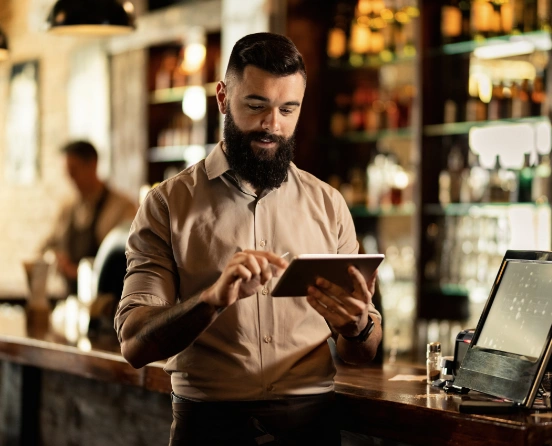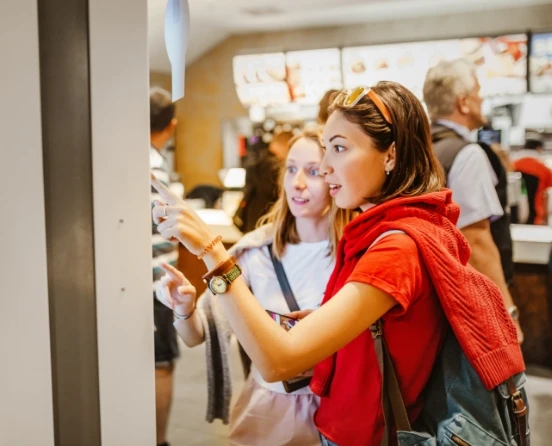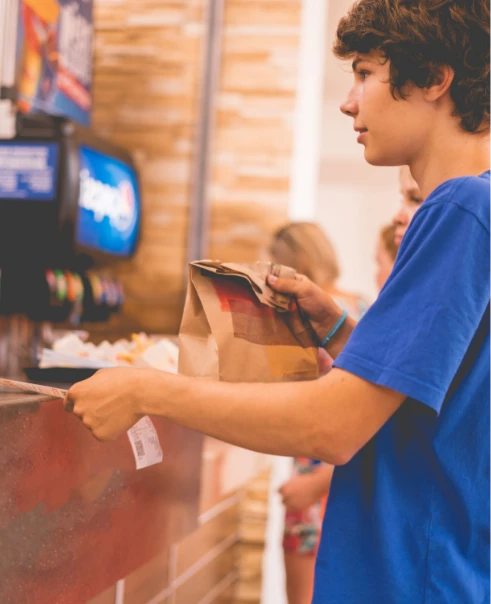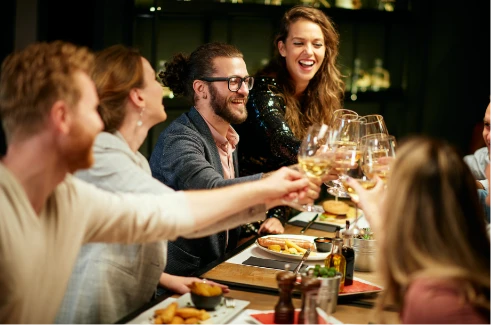Taking on
Takeout
A fully integrated approach to takeout operations.
Brought to you by Epson and ReSource Point of Sale
The past three years have seen a massive uptick in the volume of takeout orders, first normalized from the closure of in-person establishments in March of 2020. Accustomed to the convenience and enabled by delivery services, many customers have permanently changed their dining habits in favor of takeout and delivery. But for today’s restaurants, juggling takeout alongside in-person service presents a variety of unique operational challenges.
In this eBook, we will discuss how embracing the right technologies can help today’s restaurants sustain service-centered experiences for every guest—on-site and on the go—while driving new levels of profitability. Fasten your seatbelt and bring your appetite!
About ReSource Point of Sale
ReSource POS was founded in Chicago and now serves customers in offices located in Illinois, Florida, Bosnia and Paraguay. We work to empower business owners in the retail and restaurant sectors to differentiate themselves with our best-in-class solutions and services.
ReSource POS by the Numbers
- First established in 2003
- 170+ full-time team members
- 5 international offices
- Supporting more than 12,500 endpoints
About Epson
Epson is a leader in the tech arena who strives to help customers become more efficient with their durable and configurable solutions. Continuously improving their purpose-designed technology, Epson works to serve clients and partners with innovations proven to provide success.
Epson by the Numbers
- Founded in 1942
- 92,000+ employees
- Serves the hospitality and restaurant industry
- 81 group companies worldwide
A Rapid Rise in Food Delivery
From the select few to the vast majority of restaurants.
The state of food delivery and the restaurant industry today looks significantly different than it did just a couple of short years ago. In 2019, there were an estimated 703,000 restaurants in the United States. Today, this number has decreased by a significant 72,000, totaling 631,000 restaurants in the country.1 Staying above water through the pandemic proved difficult for many businesses, but it was perhaps the hardest for in-person dining establishments. In the face of in-person dining restrictions, many restaurants found a solution: takeout and delivery.
In 2020, after the pandemic began, $484 billion was spent on takeout, representing nearly two-thirds of all food orders. With more people prioritizing safety and social distancing, 89% of takeout orders were placed online, and 61% of those online orders were made to restaurants who didn’t offer takeout services before the pandemic.2 As restaurants began to recognize the effects COVID was having on ordering scenarios, they had to adapt quickly.
In 2021, almost 90% of restaurants offered takeout and 82% had delivery options.3 Restaurants who enabled delivery or takeout before the pandemic were ahead as others worked to identify an appropriate third-party platform or platforms. It is estimated that a third of restaurants use three or more platforms for delivery.4
The food delivery segment is projected to reach $231.3 billion in 2023.5
The positive business impact of these technologies is undeniable. The food service industry was predicted to reach $997 billion in sales in 2023,6 with takeout and delivery contributing significantly to that number. While accelerated by the global pandemic, the positive business impact of takeout and delivery has been evident for some time.
In 2018, 60% of restaurant owners said that offering delivery created incremental sales,7 with many restaurants citing a volume increase from 10 to 20% when using third-party services.8 This positive business impact is evidenced in the post-pandemic growth of food delivery. Valued at $192.22 billion in 2021, the delivery market is projected to reach $466.01 billion by 2030,9 increasing at a growth rate of about 10% annually.10
2014
Since 2014, online food ordering has grown 300% faster than dine-in, accounting for about 40% of total restaurant sales.11
2020
Uber’s delivery revenue increased 179% between 2019 and 2020 due to COVID.12
2021
Food delivery transactions increased 58% from the previous year.13
2024
Online food delivery revenue is predicted to reach $182 billion worldwide.14
2029
The entire food delivery app industry is expected to reach $165 billion in market size.15

The Role of the Global Pandemic
Hitting the breaks on in-person dining. Ramping up takeout and delivery.
Out of an abundance of caution and the natural fear of COVID-19’s spread, many were scared to leave their houses to get food, whether it be from a restaurant or the grocery store. In the early weeks of the pandemic, every new case brought more fear. Specifically, every 1% increase in daily new COVID-19 cases led to a 0.06% decrease in restaurant demand.16 But delivery was there to save the day.
As food delivery increased, its global market more than doubled.17 The four largest food delivery companies in the U.S. experienced remarkable growth as a result. Together, DoorDash, Uber, Grubhub, and Postmates made roughly $5.5 billion in revenue from April through September of 2020, which is more than double their combined revenue during the same period in 2019.18
Further into the pandemic, people felt more comfortable leaving their homes, but still resorted to takeout services in order to avoid in-person dining. In a study conducted by the National Restaurant Association in November 2020, 66% of respondents said they ordered takeout or delivery for dinner within the past week, and 47% said they had takeout or delivery for lunch in that same period.19
Learn more about Epson’s Liner-free Compatible Label Printer for swift, accurate orders for takeout services.
Shifting Customer Preferences
A widespread desire for on-the-go food options.
The U.S. orders take out quite often. Approximately 86% of Americans order food delivery at least once a month,20 spending at least $50 every time they order takeout.21 Over the course of a year, the average American spends $3,631 on takeout purchases.22 But takeout takes many forms. Let’s take a closer look at the nuances of customer takeout preferences.
Customers enjoy online ordering scenarios, making them visit restaurants who offer online orders 67% more frequently than restaurants that don’t.23
About 58% of customers love curbside pickup and are more likely to choose restaurants offering it and nearly 43% of customers say curbside pickup makes them more loyal to the eatery.24
63% of consumers say that it is more convenient to get delivery than dining out with a family.25
There are also generational considerations. Millennials have become accustomed to takeout and delivery, with 59% of millennial orders taking advantage of these services.26 When COVID hit, millennials were quick to jump on online ordering services. In an NRA 2020 study, 75% of millennial respondents had ordered takeout or delivery for dinner in the past week.27 When introduced to curbside pickup options rather than just delivery services, 80% of millennials said they would spend more for this pickup scenario. That number decreases to 54% for customers overall.28 This generation makes up an impressive amount of the takeout population and considers this convenience of high importance. In a 2021 study, 64% of millennial respondents (and 53% of total respondents) said that food delivery and takeout are “essential to the way they live.”29
Online Ordering vs. Third-Party Apps
Winning the takeout and delivery race.
It’s no surprise that 2020 brought a steep incline in third-party delivery app downloads, with users increasing from 36.4 million in 2019 to 45.6 million in 2020. What may be surprising is that the rate of growth continues, with users projected to reach 53.9 million by 2023.30
Despite the significant growth of third-party delivery apps, many consumers prefer direct ordering over third-party apps, with an increase of 54% in direct online order volume.31 In fact, 70% of consumers say they’d prefer ordering directly from a restaurant, so that their money goes straight to the restaurant and not a third party app.32
For restaurants, this signals a critical need to embrace third-party apps and an equally compelling opportunity to ramp up ordering channels of their own. Moreover, direct ordering channels come in all shapes and sizes—from in-browser ordering to mobile apps and traditional phone calls. By examining the behaviors and preferences of their customer base, restaurants can optimize their online ordering landscape for success.

The Future of In-Person Dining
Seamlessly switching lanes between ordering channels.
While delivery and takeout have claimed their rightful place in the food landscape, in-person dining is again alive and well. In June 2020, just 35% of consumers were comfortable dining in-person. In May of 2023, this number jumped to 77%.33 Comfortability only continues to increase, resulting in diverse and thriving dining experiences.
What does this mean for today’s restaurants? More orders from more channels with more velocity than ever before. It means the need to switch seamlessly between lanes and simultaneously prioritize orders in-restaurant and at-home. Of course, all of this is powerfully enabled by technology—which can help with order receipt, prioritization, and fulfillment. In our next section, we’ll examine some specific areas that will help today’s restaurants take on takeout and accelerate their growth.
Balancing In-person Dining and Delivery
Giving your restaurant an omni-channel tune up.
To be successful, restaurant owners need to implement methods to ensure best-in-class service no matter the ordering scenario. In fact, research indicates that a restaurant’s brand image can be vulnerable even if an order is placed through a third-party app. Approximately, 62% of consumers blame both the restaurant and the delivery company when they receive bad service.34 That means those DoorDash delivery drivers can actually impact your brand image more than you think.
Let’s look at three leading challenges to ‘taking on takeout’ and their associated solutions.
Challenges
Order volume
With 60% of U.S. consumers ordering delivery or takeout once a week and 31% using third-party delivery services at least twice a week,35 today’s order volume can be overwhelming at best. In many cases, the flow of orders challenges the historical day parts, requiring even more adaptability on the part of the restaurant.
Order velocity
Even more challenging than the volume of orders is their speed. With frictionless experiences at their fingertips, customers are ordering in record time. And their patience is at an all-time-low. The average delivery time for food is around 35 minutes, but 27% of customers are willing to pay extra for their food to arrive faster.36
Order variability
The third challenge associated with takeout and delivery is variability. These channels require different operational workflows for fulfillment and pick-up. Without the proper processes and solutions, restaurants can risk order confusion or allow third-party pickup to erode the experiences of their in-person guests.
Solutions
Order routing and prioritization
Just as a GPS system in a car navigates and reroutes based on traffic conditions to ensure the most efficient journey, order routing and prioritization technologies in restaurants guide the flow of orders. Using advanced algorithms and real-time data, these systems can dynamically adjust to changing order volumes and types, ensuring that both in-person and online orders are handled efficiently. This technology is vital in preventing order backlogs and maintaining customer satisfaction in a dining landscape that is equal parts takeout and in-person dining.
Kitchen clarity and order fulfillment
In a restaurant, the kitchen is akin to the engine of a car. To ensure smooth operations and prevent back-ups, it is critical that a restaurant maintains clear communication and efficient kitchen processes, much like a well-tuned engine. Kitchen Display Systems play a crucial role here, providing chefs and kitchen staff with real-time updates on orders, helping them manage preparation times, and ensuring that food is cooked and plated or packaged efficiently and accurately.
Order labeling and customization
Comparable to a car’s informative and accessible dashboard, effective order labeling and customization solutions are pivotal for both restaurant staff and customers, including third-party delivery drivers. For staff, labelling solutions clarify customer preferences and order specifics, ensuring each dish is prepared to exact standards. For customers and delivery personnel, they provide clear, easily visible labels to identify each order, greatly simplifying the pickup process and reducing the likelihood of mix-ups. This enhanced clarity benefits everyone involved, much like a well-designed dashboard aids a driver in making informed decisions on the road.

Take on Takeout with the Right Partner
Epson Suite of Solutions: A high powered suite for ordering, fulfillment, and labeling needs.
Online Ordering & Curbside Pickup Solutions
Balance pick-up and online ordering with an integrated solution that improves the customer experience, accurately identifies orders, eliminates errors, and fulfills orders quickly. Epson’s suite of products work together to provide your customers with the convenience they desire.
- Dynamic products to assist with order accuracy
- Wireless interfaces and cloud-capable options
- Stationary and portable printers
- Variety of receipt and label printers
Kitchen Solutions
With an influx of orders from online sites and third-party apps, the kitchen is a busy and demanding environment. Epson’s kitchen solutions are equipped to help optimize your front and back-end restaurant operations, increasing speed of service.
- Order ticket and receipt printing
- Scalable single or multi-station Kitchen Display Systems (KDS)
- Route orders to kitchen and prep stations
- Easily integrated into many POS solutions including traditional and mobile
Labeling Solutions
Epson created a line of label printing solutions that offer thermal and color label printing. Their versatile print capabilities enable you to create customizable high-quality labels quickly and easily to ensure your customers are getting the correct order.
- Personalized order labels
- Monochrome and color label printers
- Traditional and liner-free printers
- Stationary and portable printers
ReSource Point of Sale
A green light for fast-growing restaurants.
Taking on takeout can be challenging, but the right partnership can help you win the race. At ReSource Point of Sale, we partner with fast-growing restaurants as they navigate changing customer preferences, ordering channels, business realities, and more. And we represent some of the most innovative and trusted technology brands in the hospitality world. We are proud to partner with Epson, who delivers solutions that help address the key operational aspects of adapting to takeout and delivery.
With a highly collaborative approach, we work with you to understand and achieve your restaurant’s goals—from initial solution design to rollout and ongoing support.
Solution Design
Create a unique suite of solutions for your individual needs
Install and Integration
Promote speed, accuracy, and efficiency
Training and Support
Collaborative approach to achieve your business goals
Customer Satisfaction
Ever-evolving solutions to breed loyalty
How can we help you?
Allow us to put our commitment to client success to work for your business.
